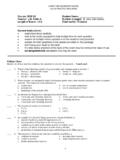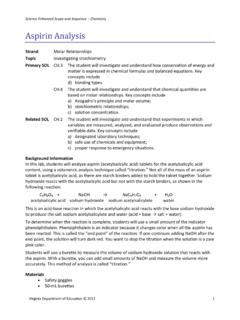Transcription of FindingtheFormulaandPercent&Composition&
1 Science Enhanced Scope and Sequence Chemistry Finding the Formula and Percent Composition Strand Molar Relationships Topic Investigating mole ratios to determine chemical formulas and percent compositions Primary SOL The student will investigate and understand that chemical quantities are based on molar relationships. Key concepts include b) stoichiometric relationships. Related SOL The student will investigate and understand how conservation of energy and matter is expressed in chemical formulas and balanced equations. Key concepts include e) reaction types. The student will investigate and understand that chemical quantities are based on molar relationships. Key concepts include d) acid/base theory; strong electrolytes, weak electrolytes, and nonelectrolytes; dissociation and ionization; pH and pOH; and the titration process.
2 Background Information When chemical reactions occur, there is a conservation of mass and energy. Because of the conservation of mass, we can measure the masses of starting materials and the masses of products and compare them to determine the chemical formulas of the reactants or products. One of the most important things we can learn about a compound is its chemical formula. The formula for a compound that expresses the smallest whole- number ratio of the atoms present is called an empirical formula. For example, a compound with the formula C4H8O4 and a compound with the formula C6H12O6 have the same empirical formula, CH2O. The formula for a molecular compound that gives the actual number of atoms per molecule is called a molecular formula. The molecular formula C6H12O6 can be represented as a whole.
3 Number multiple of the empirical formula (CH2O)6. To calculate the empirical formula of a compound, we first determine the relative masses of the various elements that are present. One way to do this is to measure the masses of elements that react to form the compound. For example, suppose we put a mass g of pure nickel metal into a crucible and heat the metal in air so that the nickel reacts with oxygen to form a nickel oxide compound. After the sample has cooled, we determine its mass again and find its mass to be g. The increase in mass is due to the oxygen that reacts with the nickel to form the oxide. Therefore, the mass of oxygen present in the compound is the total mass of the product minus the mass of the nickel: g g = g. Because the mass of nickel present in the compound is the same as mass of the original nickel metal, we know that the nickel compound contains g nickel and g oxygen.
4 The steps for determining the empirical formula for a compound are the following: 1. Convert the grams of each element in the compound to moles of atoms of each element. 2. Determine the whole- number mole ratio of each element to the other(s). 3. Write the formula. Virginia Department of Education 2012 1 Science Enhanced Scope and Sequence Chemistry Materials Standard test tubes (18 x 150 mm) Wooden splints M HCl Beral pipettes or disposable pipettes Magnesium ribbon Electronic balances (or analytical balance, if one is available) Calculators Vocabulary chemical formula, molar relationships, mole, percent composition, stoichiometric, stoichiometry Student/Teacher Actions (what students and teachers should be doing to facilitate learning). 1. Have students work independently to determine the molar mass of an ionic compound, such as ammonium sulfate, (NH4)2SO4.
5 Instruct them first to calculate the molar mass of the compound by writing its formula and adding up the masses of the elements in the compound. Then, ask them how they would calculate the percent of each element in the compound, , the percent composition. (Divide the mass of each element by the molar mass of the entire compound and then multiply by 100.) After they have finished their calculations, have them discuss their answers in pairs. Select three pairs of students to share their answers with the class, making sure everyone accurately calculated the molar mass. Work through the steps of the process with the class, as follows: Molar mass of (NH4)2SO4 = g/mol Percent H = 8( g) g/mol = 100 = H Percent N = 2(14 g) g/mol = 100 = N Percent S = 1(32 g) g/mol = 100 = S Percent O = 4(16 g) g/mol = 100 = O [Or, percent O = 100 ( + + ) = O] 2.
6 Define empirical formula, and discuss the concept of an empirical formula with the class. Introduce molecular formulas. Instruct students in how to calculate the empirical formula of a compound. 3. Guide students in calculating the empirical formula for nickel oxide as described in the background information above, using the following steps: g Ni g/mol Ni atoms = mol Ni atoms g O g/mol O atoms = mol O atoms These mole quantities contain an equal number of atoms. It is clear from the moles of atoms of each substance that the mole ratio is 1:1. Therefore, the formula is NiO. This is the empirical formula because it expresses the smallest whole- number ratio of atoms. All ionic compounds are expressed as empirical formulas; we would never write, for example, Ni2O2. Virginia Department of Education 2012 2 Science Enhanced Scope and Sequence Chemistry 4.
7 Have students find the empirical formula for a compound containing g of Pb, g H, g As, and g O. Have four students come to the board and write one of the four steps in the process, as follows: g Pb g/mol Pb = mol Pb g H g/mol H = mol H g As g/mol As = mol As g O g/mol O = mol O Divide these mole values by the smallest number of moles to get the whole- number mole ratio: mol Pb = 1 mol Pb mol H = 1 mol H mol As = 1 mol As mol O = 4 mol O Therefore, the empirical formula for the compound is PbHAsO4. 5. Inform students that when a g sample of vanadium metal is heated in air, it reacts with oxygen to form an oxide compound with a mass of g. Have student work in pairs to calculate the empirical formula for this sample of vanadium oxide, as shown in the following steps: g g = g (mass of oxygen that reacted) g V g/mol V = mol V g O g/mol O = mol O Divide these mole values by the smallest number of moles to get the whole- number mole ratio: mol V = 1 mol V mol O = mol O Since one of these numbers, , is not a whole number, multiply both numbers by the lowest possible number (2) that will result in two whole numbers and therefore form a whole- number ratio: 1 2 = 2 V 2 = 5 O Hence, the whole- number ratio is 2:5.
8 (Note that this step is necessary only if the mole numbers are not already whole numbers.) Therefore, the empirical formula for the compound is V2O5. 6. Next, have students perform an experimental investigation in which they form an ionic compound from the elements magnesium and chlorine. They will determine the empirical formula for this compound by comparing the moles of each element that react and determining the mole ratio of one element to the other. They will also determine the percent composition of the compound. Have students do the experiment, as follows: a. Create a data chart to display the following data: Mass of clean, dry test tube Mass of magnesium ribbon Mass of test tube and product Mass of product Observation of glowing splint test Virginia Department of Education 2012 3 Science Enhanced Scope and Sequence Chemistry Identity of gas b.
9 Select a standard 18 x 150 mm test tube, and make sure it is clean and dry. Find the mass of the test tube, and record it in the data chart. c. Find the mass of approximately grams of magnesium ribbon. It is not necessary to have exactly grams, but do not be too far off. Record in the data chart the exact mass of the magnesium ribbon used. Put the magnesium ribbon in the test tube. d. Fill a beral pipette with M HCl. CAUTION! 3M HCl is a strong acid and should be handled very carefully. Add the acid to the test tube, a few drops at a time. Run the drops down the inside wall of the test tube, holding the test tube at a slight angle. CAUTION! Do not add the acid all at once. e. While the reaction is proceeding, test the gas being produced with a glowing splint. What is the identity of the gas?
10 F. Continue to add the acid until the reaction is complete , until there is no visible solid magnesium left. Avoid adding excess acid. g. Set up a Bunsen burner. Using a small flame, start to evaporate the liquid in the test tube. Be sure to hold the test tube at a 45- degree angle. Keep the test tube moving in the flame, and do not heat just the bottom of the test tube. CAUTION! Follow safe laboratory practices by always pointing the test tube away from yourself and others. h. When evaporation appears complete, test by removing the test tube from the flame and inverting a clean, dry test tube over the mouth of your test tube. If you observe condensation forming in the top test tube, then continue heating the original test tube a few minutes longer and test again with another clean, dry test tube.













